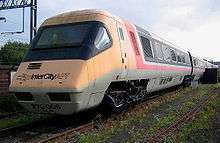British Rail Engineering Limited
| Industry | Train and carriage building |
|---|---|
| Fate | Privatised |
| Predecessor | British Rail Workshops |
| Successor | Bombardier Transportation |
| Founded | 31 October 1969 |
| Defunct | 1989 |
| Headquarters | London, United Kingdom |
| Parent | British Railways Board (1969-1989) |

British Rail Engineering Limited (BREL), incorporated on 31 October 1969, was the railway systems engineering subsidiary of British Rail until the design and building of trains in the UK was privatised in 1989.[1]
Main products

The vast majority of BREL's output was for British Rail, including Mark 1, Mark 2 and Mark 3 carriages, the latter for locomotive haulage and InterCity 125 diesel High Speed Trains. BREL built the NIR 80 Class diesel-electric multiple units for Northern Ireland Railways. Other Mark 3 derived vehicles included Class 150 diesel multiple units in the 1980s and numerous electric multiple units such as Classes 313 and 317.
BREL had limited success in the export market, notably with Mark 2 and Mark 3 carriages for Irish Rail and the Taiwan Railway EMU100 series.
Other products


BREL built prototypes such as the Class 210 DEMU and the experimental high-speed Advanced Passenger Train (APT) tilting during the 1970s and early 1980s.[2] The Class 210 were externally very similar to the first batch of Class 317 EMUs, but half of the forward carriage was taken up by the engine room. Power was provided by an above-floor diesel engine driving a generator to power traction motors on the axles. A single engine was fitted at one end of the unit.
Locations
BREL major production centres were at Crewe (Crewe Works), Derby (Derby Carriage and Wagon Works and Derby Works), Doncaster (Doncaster Works), Shildon (Shildon Works) and York (BREL York). The historic site at Wolverton in Milton Keynes was progressively run down until the 1980s before being relegated to maintenance duties.
Not all British Rail rolling stock was built in house: Metro Cammell, Brush Traction and Metropolitan-Vickers amongst others manufactured rolling stock, although in general it was built to BREL specifications. Latterly, BREL often acted as a sub contractor to a main contractor such as GEC, which supplied traction equipment. These contracts required BREL to build the frames, body shells and bogies, and install the traction and ancillary equipment of the primary contractor. Much of the electric locomotive construction programme of the 1980s, such as Classes 87, 90 and 91, was carried out in this way.
Privatisation
In 1989 BREL was purchased by the Swiss-Swedish conglomerate ABB (ASEA-Brown Boveri) (40%), Trafalgar House (40%) and a MEBO (management-employee buy-out) (20%). In 1992 it was bought out by ABB to form ABB Transportation Ltd.[3] It has since become part of Bombardier Transportation.
The privatisation of British Rail led to a hiatus in the ordering of rolling stock, which predictably led to the almost complete collapse of the rolling stock manufacturing industry. When purchases of rolling stock resumed, with little remaining capacity in the UK contracts were increasingly placed overseas.
In 1996, BREL York closed.
In 2005, the unrelated Metro-Cammell plant in Washwood Heath, Birmingham, closed, which meant that for ten years from 2005 to 2015, Bombardier's former BREL site, the Litchurch Lane Works in Derby, was the sole plant in the UK actively manufacturing stock. (This unique role was ended by Hitachi and John Laing in 2015, who opened the Agility Trains factory in County Durham.)
Like Metro Cammell, BREL helped in the planning, design and, on occasion, the manufacturing of London Underground stock.
See also
References
- ↑ "British Rail Workshops". www.railwaybritain.co.uk.
- ↑ "This is British Rail (reproduction of the text of a British Rail leaflet)". www.apt-p.com.
- ↑ Industrial Railway Society Bulletin No 544, January 1993
External links
| Wikimedia Commons has media related to British Rail Engineering Limited. |